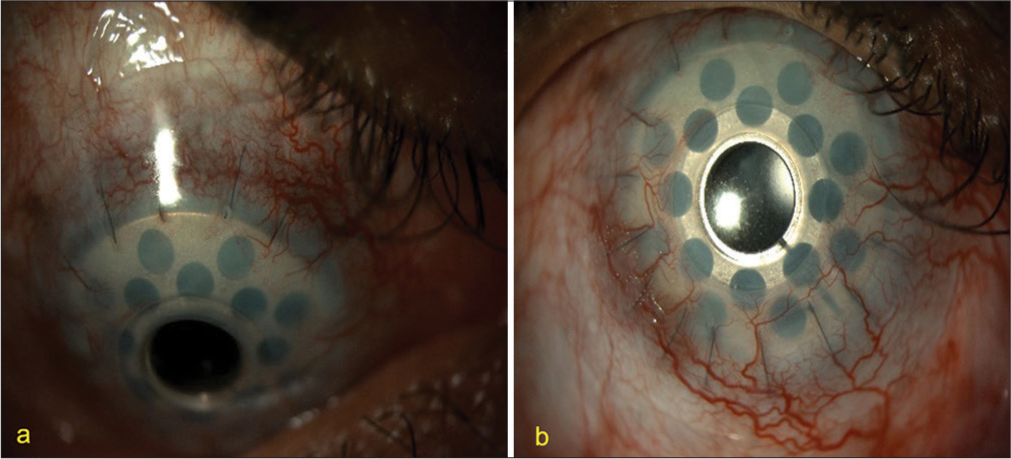Translate this page into:
Dual role of bandage contact lens – A case report

*Corresponding author: Manju Balakrishnan, B.Opt, FCL, Senior Optometrist, Department of Contact Lens, Sanakara Nethralaya, Chennai, Tamil Nadu, India. manjub1122@gmail.com
-
Received: ,
Accepted: ,
How to cite this article: Balakrishnan M. Dual role of bandage contact lens – A case report. Lat Am J Ophthalmol. 2024;7:14. doi: 10.25259/LAJO_20_2024
Abstract
Bandage contact lens (BCL) wear is important in the post-operative management of many corneal diseases to maintain appropriate hydration, protection, and minimize the chances of adverse complications. Boston Keratoprosthesis (KPro) is a treatment option for corneal disease not amenable to standard penetrating keratoplasty. A patient reported with vision drop followed by chemical injury (acid exposure). His unaided vision OD: HM+, OS: CF @ 50 cm. Underwent Kpro in the right eye, and vision improved to 6/9 with −6.50 ds, left noted physical eye. Post-surgery BCL with 8.8 base curve, 14.2 diameter along with −6.50 ds power was fitted to satisfy the visual need.
Keywords
Bandage contact lens
Keratoprosthesis
Vision
Therapeutic contact lens
Soft contact lens material
INTRODUCTION
Contact lenses play an important role in the treatment of corneal diseases. The types of contact lenses most commonly used for therapeutic purposes include soft lenses and scleral lenses. It provides a therapeutic benefit by providing a mechanical barrier between the cornea and the external environment, providing continuous hydration to the cornea, aiding wound healing, and reducing pain. Bandage contact lenses (BCLs) are used to treat a variety of corneal conditions, including corneal epithelial defects, corneal erosions, and post-surgical conditions such as Keratoprosthesis (Kpro) and post-laser correction.
In this case, the role of BCL is seen in the elective corneal prosthesis Boston Ortho (KPro). Corneal transplantation is an indication of corneal edema or corneal opacification.[1,2] Although corneal transplantation is considered one of the most successful organ transplants, corneal transplants have a limited lifespan, especially when host tissue is damaged, and previously This is especially true in patients with failed transplants.[2] The prognosis for successful penetrating keratoplasty (PK) with the Boston type 1 corneal prosthesis (KPro), an artificial cornea, is thought to be.[1,3]
To reduce post-operative complications such as corneal fusion, long-term continuous BCL placement has become the standard of care in the post-operative management of KPro patients.[4,5] BCL maintains good hydration and minimizes exposure of corneal tissue adjacent to the anterior plate of KPro, especially susceptible to evaporative desiccation.[4-6] This case report provides a possible refractive correction with BCL to meet the vision needs of the patient.
CASE REPORT
A 30-year-old male presented for BCL wear over an existing type I Boston KPro. The relevant ophthalmic history observed was a dimension of vision in both eyes followed by chemical injury, accidental acid exposure while cleaning and draining the ship, followed by have undergone multiple times surgical interventions, which include amniotic membrane transplantation (AMT) in both eyes and failed PK in the left eye. On presentation patient’s, vision was hand movement in the right eye and counting fingers at 50 cm in the left eye.
Despite multiple ocular surgeries, the patient was motivated to further surgical intervention. He is placed in the Navy and expresses a strong desire to try to regain any vision possible in his right eye and his left is pre-physical. A decision was made to proceed with KPro due to the high chances of Graft failure in the right eye also. He underwent combined surgery of KPro with cataract extraction and followed proper post-operative care. Vision improved to 6/9 with refractive correction of −6.50 ds and near vision reads N6 with +3.00 ds addition power. The patient was referred to the contact lens clinic for BCL along with refractive correction as the patient does not want to wear over-corrective glasses. The patient was fitted with Air Optix (lotrafilcon B) BCL 8.6 mm Base curve, 14 mm diameter, and −6.00 ds power. BCL fit assessment shows good coverage with adequate lens movement on the eye, given adaptation for around 30 min. BCL was centered, showing optimal fit on the eye [Figure 1a]. With this well–fit lens in the settings of KPro placement, visual acuity in the right eye improved to 6/9. The patient was reviewed the next day to observe any symptoms and clinical signs. BCL fit was good [Figure 1b], the patient was subjectively comfortable with BCL and happy regarding the vision, instructed to replace the BCL monthly. Table 1 elaborates the commonly used BCL in conditions of KPro.

- (a) Acceptable fit with Lotrafilcon B contact lens (Day 1) and (b) acceptable fit with Lotrafilcon B contact lens (Day 2).
| Type of contact lens | Study | Base curve (mm) | Diameters (mm) |
|---|---|---|---|
| Air Optix day and night Aqua | 1 | ** | 13.8 |
| 2 | ** | ** | |
| 6 | 8.4 | 13.8 | |
| 13 | ** | ** | |
| Accuvue Oasys | 2 | 8.4 | 14 |
| 10 | ** | ** | |
| 17 | ** | ** | |
| Focus night and day | 10 | ** | ** |
| 17 | ** | ** |
DISCUSSION
Over the ocular surface of the KPro eye, a BCL that is appropriate and has good retention and tolerability is applied.[4] After KPro care has been reported to use silicone hydrogel BCLs with more regular replacement schedules, which have the advantages of multipack packing and reduced cost. However, parameter availability is constrained with such standard lenses, with the majority of their diameters falling between 13.8 mm and 14.5 mm.[1] The Air Optix Night and Day Aqua (Alcon, Lotrafilcon A, Fort Worth, Texas, USA) is one such lens that has been mentioned in numerous research and may be favored due to its high Dk and affordable price.[2,6-8] Other silicone hydrogel lenses that have been considered include Acuvue Oasys, Senofilcon A (Vistakon, Jacksonville, FL), Biofinity, Comfilcon A (Cooper Vision, Fairport, NY), and Focus Night and Day (CIBA Vision, Duluth, GA; discontinued), although achieving satisfactory fit over KPro devices with standard soft lenses may be difficult and not always possible.[2,9]
Second, Beyer et al. discovered that using low water-content nonionic lenses improved deposit accumulation.[4,10] In the past, soft contact lenses (SCL) were primarily used for vision correction, but new advancements in material technology have expanded its usage as a BCL in a variety of corneal conditions.[10] When Kpro patients are fitted with BCL, it enables a therapeutic role by reversing corneal desiccation and fine-tuning refractive correction. Even though lenses stay in place, are clean, and are comfortable for several months, they still need to be updated on occasion, which increases the cost and chair time. At the same time, the refraction on the Kpro eye can fluctuate and providing refractive BCL possibly provides a monetary advantage over frequent changes of more expensive glasses.
CONCLUSION
This case report demonstrates the benefit and practicability of SCL wear after Boston KPro. It is evident from our study that BCL is generally well retained in KPro eyes, thus allowing the carrier corneal graft to remain well-hydrated. BCL also claims refractive role in the post-operative management of KPro patients.
Ethical approval
The Institutional Review Board approval is not required.
Declaration of patient consent
The authors certify that they have obtained all appropriate patient consent.
Conflicts of interest
There are no conflicts of interest.
Use of artificial intelligence (AI)-assisted technology for manuscript preparation
The authors confirm that there was no use of artificial intelligence (AI)-assisted technology for assisting in the writing or editing of the manuscript and no images were manipulated using AI.
Financial support and sponsorship
Nil.
References
- Contact lens use in patients with Boston keratoprosthesis type 1: Fitting, management, and complications. Eye Contact Lens. 2015;41:334-40.
- [CrossRef] [Google Scholar]
- Contact lens fitting and long-term management for the Boston keratoprosthesis. Eye Contact Lens. 2014;40:185-9.
- [CrossRef] [Google Scholar]
- Outcomes of pars plana glaucoma drainage implant in Boston type 1 keratoprosthesis surgery. J Glaucoma. 2014;23:e39-44.
- [CrossRef] [Google Scholar]
- The role of soft contact lenses as an adjunct to the Boston keratoprosthesis. Int Ophthalmol Clin. 2008;48:43-51.
- [CrossRef] [Google Scholar]
- Resolution of an exposed pars plana Baerveldt shunt in a patient with a Boston keratoprosthesis type 1 without surgery. Ther Adv Ophthalmol. 2019;11
- [CrossRef] [Google Scholar]
- Global consensus on keratoconus and ectatic diseases. Cornea. 2015;34:359-69.
- [CrossRef] [Google Scholar]
- Contact lens surveillance cultures in Boston type 1 keratoprosthesis patients. Eye Contact Lens. 2013;39:175-8.
- [CrossRef] [Google Scholar]
- Contact lens modifications for Boston keratoprosthesis. J Contact Lens Res Sci. 2022;6:e9-17.
- [CrossRef] [Google Scholar]
- Microbial keratitis after Boston type I keratoprosthesis implantation: Incidence, organisms, risk factors, and outcomes. Ophthalmology. 2013;120:2209-16.
- [CrossRef] [Google Scholar]
- Prevention of visually debilitating deposits on soft contact lenses in keratoprosthesis patients. Cornea. 2011;30:1419-22.
- [CrossRef] [Google Scholar]






